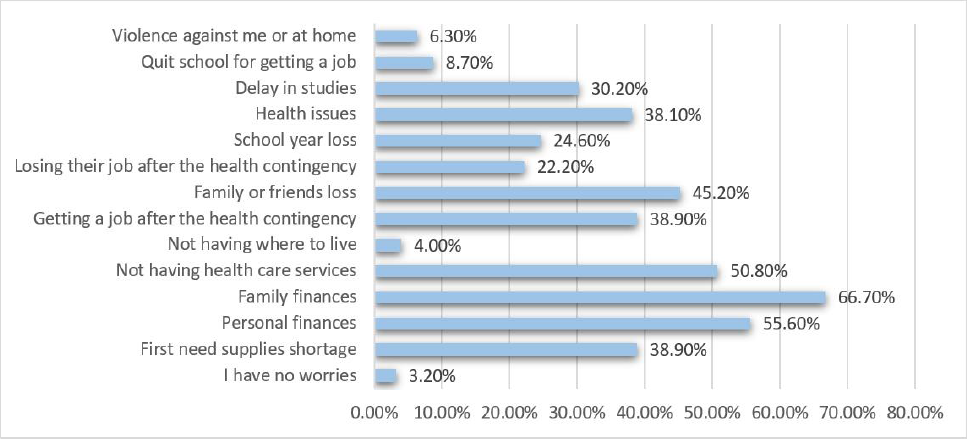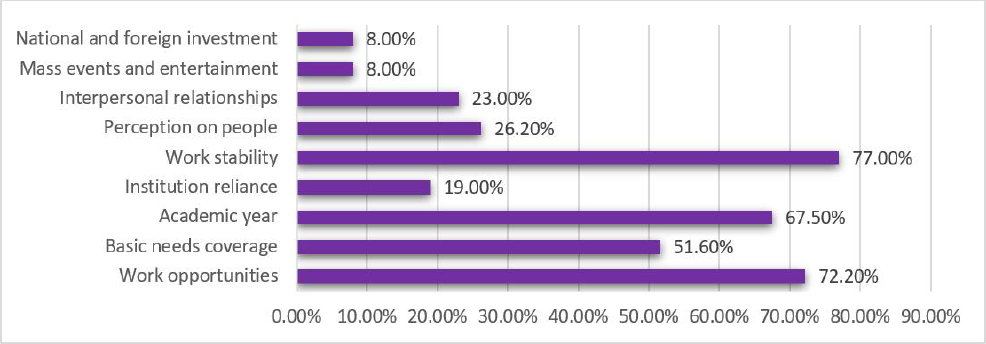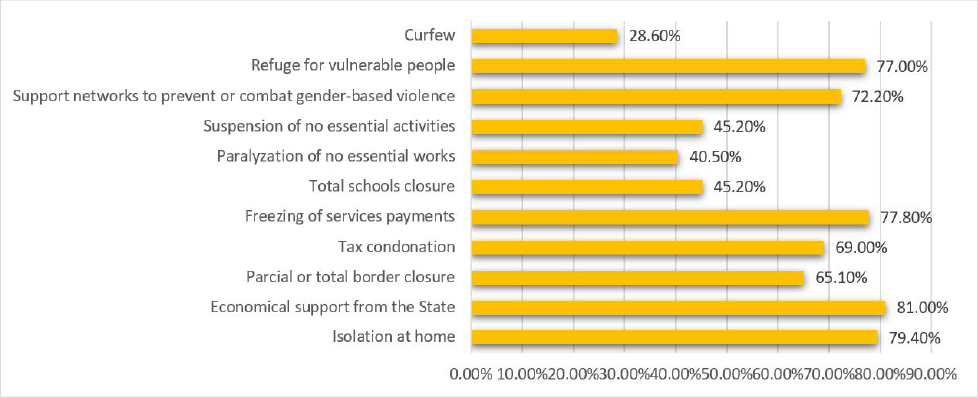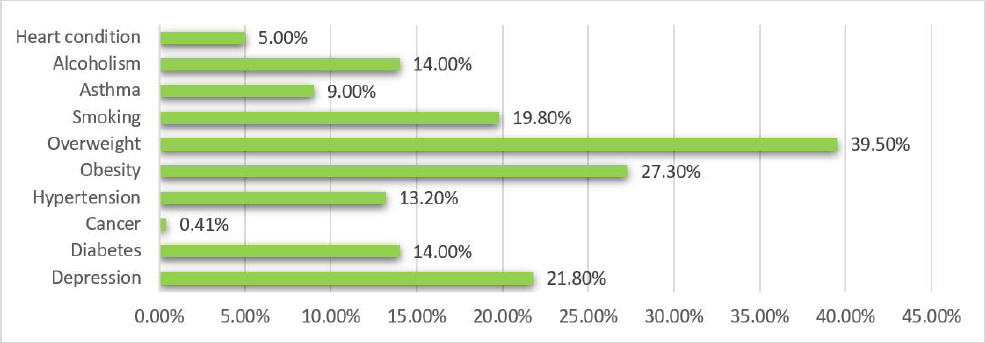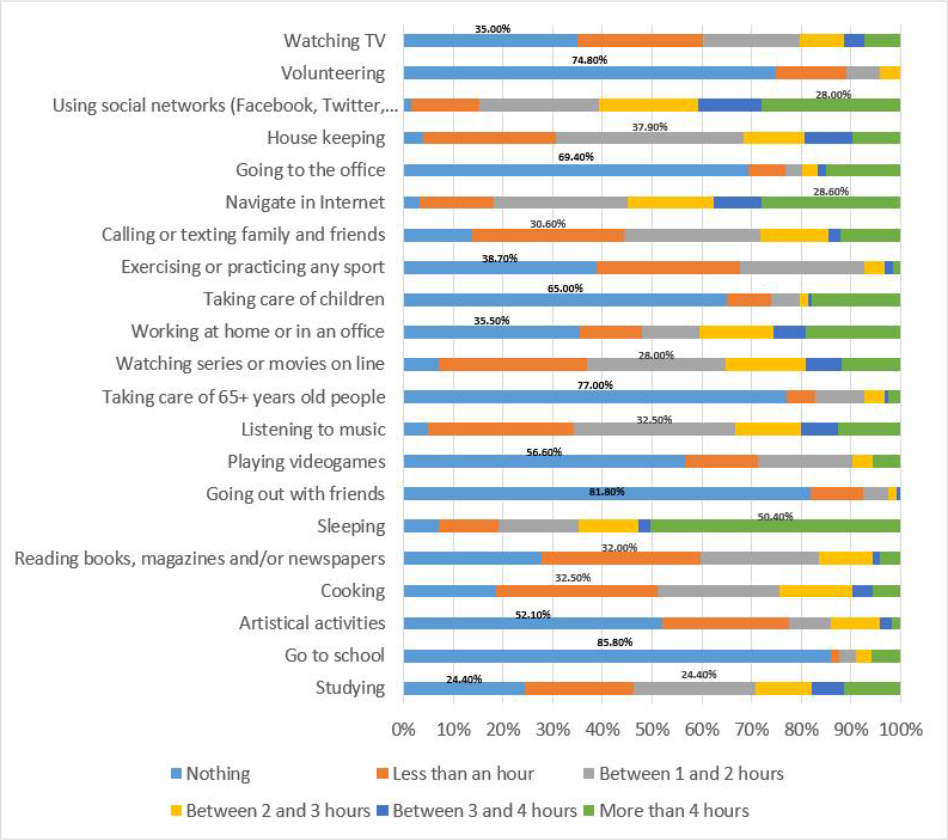Introduction
At the end of December 2019, Wuhan Municipal Health Commission, China, reported a cluster of cases of pneumonia in Wuhan, Hubei Province OMS (2020a). They are later determined to be caused by a new Severe Acute Respiratory Syndrome (SARS) caused by a new coronavirus, SARS-COV-2 (Kalazich Rosales et al., 2020).
On March 11th, the director of the WHO (World Health Organization) stated that in the past two weeks, the number of cases of COVID-19 outside China has increased 13-fold, and the number of affected countries has tripled. There are now more than 118,000 cases in 114 countries, and 4,291 people have lost their lives and concluded that COVID-19 can be considered a pandemic (OMS, 2020b)
The first case of COVID-19 was detected in Mexico on February 27, 2020 (Suarez, Quezada, Oros, & Ronquillo de Jesus, 2020). The first death from this disease in Mexico occurred on March 18th, 2020, he was a 41-year-old man (BBC News, 2020). The first cases in the State of Michoacan officially are set on March 20th, 2020, with the arrival of four people from Spain, three of them in Morelia, and one in Ciudad Lazaro Cardenas (Martinez, 2020). On March 26th, the first death in the state of Michoacan (Inobae, 2020) is confirmed, and therefore, the beginning of confinement, especially for young people of schooling age.
Worldwide, the contingency generated by the new coronavirus SARS-CoV-2, has led to great changes in all aspects of modern life. In all countries, different governments have taken dissimilar measures to face this health crisis; the strategies that have been presented at an international level are such as confinement, partial or total border closure, physical distancing, as well as the closure of schools, public spaces, recreational activities, and non-essential businesses to guarantee the proper functioning of society. The strategies implemented by governments have produced different results among nations since individuals comply differently with these measures due to the perception of the population about the virus, while some Asian countries have managed to contain the spread of the disease, other countries in America maintain record levels of infections and deaths.
In the case of Mexico, a diverse country in natural resources and ways of thinking, there is still a considerable percentage of the population that perceives the health situation as false or non-existent. On the other hand, the young population has been participatory and informed about the pandemic. The subjects of this study are people from 16 to 29 years old who live in Morelia. According to the arguments presented, this document will be discussed the following:
To identify the perceptions of the young community aged from 16 to 29 years old in the city of Morelia, Michoacan, Mexico during the health contingency of the COVID-19 (disease generated by the new coronavirus SARS-CoV-2).
Review of Literature
The Meaning of Youth
According to OIJ (in Portuguese: Organismo Internacional de Juventude para Iberoamérica), we are often tempted to establish an age range that allows us to cover this sector of the population. This range, variable according to countries or international settings, can be established taking into account biological and psychological elements of the human being that indicate the end of childhood and the entry at puberty, it is also defined at an age of 15 to 24 years, established globally by the United Nations for the Year of Youth 1985 of the World Health Organization (WHO) (OMS, 2000). It also can be explained by the socio-economic and political conditions of the countries, which affect the life trajectories and determine the beginning and end of the educational stages, labor insertion, the beginning of new families. But it is also due to the political or strategic vision of those who address youth issues.
In this time of crisis, innovative and adaptive practicing methods will be required in society. Restructuring services to respond to the current public health crisis, governments, public health bodies, and policymakers must review problems and make full use of any young people's potential (Cadogan & Hughes, 2020), as long as this means to empower this group of people.
The Crisis
It is important to study the effects of the coronavirus in our society; different fields have begun with studies; for example, social media is an important element in disaster and health crisis, in their study Yu, Li, Yu, He, and Zhou (2020) analyzed online comments related to COVID-19 through automated and manual content, the key themes are identified and discussed, including dynamically risk perception, the effects of enterprises’ service quality in crisis, the quarantine issues in public health, the authenticity of media coverage, and racial discrimination.
Different authors agree that the responsibility of this situation control has to be from the different governments, Hartley and Perencevich (2020) consider that monitoring infection rates and effective reproduction numbers continuously, may effectively allow for quality improvement methods to be used to evaluate public health policies. And these policies generate strategies that affect directly to the population; for example, in Spain, one of the government strategies was that people with intellectual disabilities or autism were allowed to go out into the streets, according to Arango (2020), which was done with the best of intentions (to minimize behavioral problems in this vulnerable population), however, this is precisely a population that must not become infected because 1) managing them in the hospital is very difficult for both, them and the system, especially now; 2) a relative will also be infected, as they need someone with them; and 3) sadly enough, they are not eligible for ICU care.
The pandemic continues to pose a serious public health threat to nations around the world, as effective antiviral therapeutics or vaccines are yet to be developed, the priority for the government is to limit transmission and define clinical management that improves the cure rate and effectively reduces the overall mortality rate. To achieve this goal, a complete understanding of all aspects of coronaviruses is needed to prevent or lessen their threat to society in the future. A thorough understanding of the epidemiology, pathophysiology, and pandemic response efforts to combat COVID-19 is an invaluable lesson to society providing a protocol to fight future pandemics should they occur (Pollard, Morran, & Nestor-Kalinoski, 2020).
Public and Mental Health
Different public health problems affect the youth population but we don’t believe that the risks associated with COVID-19 meet the bar, for example, the pandemic has emphasized the need to provide information and support to women related to their decisions to pursue or delay pregnancy (Rasmussen, Lyerly, & Jamieson, 2020). Stress is a prominent risk factor for the onset and maintenance of alcohol misuse, the effects of long-term social isolation on stress levels, have begun to affect society, however, the ongoing lockdowns across many countries are unique, and little is known of the effects on the general population of chronic isolation in these circumstances (Clay & Parker, 2020). The pandemic has disrupted the habits of billions of people around the world, lockdown at home is mandatory, forcing many families, each member with their sleep-wake habits, to spend 24 hours a day together, continuously. Sleep is crucial for maintaining immune systems and contributes deeply to physical and psychological health, Beck et al. (2020) suggest that the crisis is associated with severe sleep disorders among the population, especially young people.
In Mexico, important steps were taken to diminish risks during the emergency, according to Medina‐Mora, Cordero‐Oropeza, Rafful, Real, and Villatoro‐Velazquez (2020), it is shown a decrease in acute alcohol intoxications cared for in emergency rooms during the lockdown. The alcohol industry was classified as non-essential, forbidding it from producing alcohol, and laws limiting availability, health promotion campaigns, and promotion of access to treatment were endorsed. Significant efforts in alcohol policy were made, despite Mexico being a country with no sustained integrated policy, an impoverished health system, which also, had experienced significant budget cuts before the pandemic. Liang et al. (2020), found that mental health problems remain serious among most youth group during a public health emergency, their study indicated that low education level, enterprise employee, and negative coping styles were the influence factors of youth mental health, their results highlight the need for local governments to take appropriate mental health interventions based on the characteristics of youth groups.
The last outbreaks in China and other parts of the world can understand that public mental health interventions should be formally integrated into public health preparedness and emergency response plans to effectively curb all outbreaks. As the virus spreads globally, governments must address public mental health needs by developing and implementing well-coordinated strategic plans to meet these needs during the pandemic (Dong & Bouey, 2020). Not much is known about the long-term mental health effects of lockdown on youth people, but it can be hypothesized that some of them could adopt or reinforce unhealthy behaviors, considering children and adolescents, the emerging risk justifies proposing specific adaptations and type of activities to avoid the installation of unhealthy habits and ensure maintaining health underpinned, at least partly, by physiological health and physical fitness (Margaritis et al., 2020).
Cultural and Social Effects
Some of the public problems related to the contingency are racial discrimination and refugees, the racial discrimination represents a violation of human rights; all human rights legislation seeks to uphold each person’s right to coexist without discrimination, no matter their country of residence, news reports regarding racial discrimination against the Chinese during the first outbreak could have far-reaching effects beyond a personal level (Endale, St Jean, & Birman, 2020; Hightow-Weidman et al., 2020; Wen, Aston, Liu, & Ying, 2020)
According to Makino, Kanie, Nakajima, and Takebayashi (2020) during the outbreak, the mental health of health care workers has become a major public health concern, particularly in Japan, women health care workers are experiencing a mental health crisis because of gender imbalance. The problems of imbalance it is also presented with minorities, Gibb et al. (2020) agree that people are facing significant structural and discrimination, exposing and worsening disparities and producing new ones.
In terms of jobs, the unemployment rates presented in the world are likely to underestimate the actual rate and do not cover all people who would have been classified as unemployed in a typical recession, Inanc (2020) says that Covid-related business and school closures, as well as stay-at-home orders, cause a change in people’s job-seeking behavior, which, in turn, affects who is classified as unemployed and as out of the labor force, in a typical recession, people who lose their jobs transition into unemployment because they start looking for a job, while in the COVID-19 context, however, where many non-essential businesses, schools, and daycares are closed and stay-at-home orders are put in place, people who leave employment are less likely to look for a job than would be typically the case.
Another cultural challenge is the variability among families and technological literacy, unfortunately, most of the gaps in technology and Internet accessibility, are gaps associated with race and ethnicity (Gurwitch, Salem, Nelson, & Comer, 2020). On the other hand, Wenczenovicz (2020) shares that that only 30% of the educators were safe with the new digital practices, many denounce that they are being forced to exercise the new duties and functions in the digital world, the difference can be explained specifically due to unequal conditions of infrastructure and teacher formation for the pedagogical use of technology, these experiences indicate that the teaching-learning process in times of a pandemic is more of uncertainty than certainty and that most of them are unable to evaluate their performance in the teaching process
Finally, the media plays an important role in the cultural effects, according to Ogbodo et al. (2020), it reinforces the relationship between media framing of health crisis and people’s perception and response to the risks of the virus, human interest and fear/ scaremongering dominated the coverage and this could potentially trigger more health challenges, especially for people with underlying health conditions, there is also a significant difference between how media framed hope and fear, the perception plays an important role in affecting the mental health of people in a public health crisis, therefore, health policies aiming to improve the psychological wellbeing of the people in a public health crisis should consider risk perception (Ding et al., 2020; Garfin, Silver, & Holman, 2020).
Method
This research used a non-experimental, cross-cutting, and exploratory design, descriptive as it sought to know the perceptions of young people in the city of Morelia in the face of the COVID-19 pandemic, produced by the worldwide spread of the SARS-CoV-2 virus.
Design of the Study and Subjects
The information was collected during May, June, and July using Google forms, and in some cases, it was done in person, implementing all the health measures established by the authorities, all this was carried out in the city of Morelia, Michoacan. The subjects of the study were young people from 15 to 29 years old with residence in the city of Morelia, Michoacan.
Measuring instrument
For the implementation of this research, the measuring instrument was built reaching a preliminary version of 121 items; however, when applying the pilot test, we realized that they were not feasible since the young people did not answer the survey, leading to the rethinking of the number of questions that integrated the final questionnaire.
To validate the measuring instrument, there were used five judgments from methodological experts, who examined the questions and the answers, therefore, their comments allowed to establish that every question was perfectly valid to measure. Thus, we have reached the final instrument.
This final instrument consists of 48 questions as follows (see Appendix 1): eight sociodemographic questions, thirteen integrating the perception of contingency, eight of them ask about aspects of health, fourteen are grouped in education and employment and finally, five questions, which inquire into consumption habits in the youth of the city of Morelia, Michoacán Mexico, the processing of the data was carried out using the SPSS statistical program v.24 and assisting us with the Excel program and the graphs provided by the Google Forms platform.
Procedure
Once the data was obtained from the Google Forms platform, they were exported to the SPSS v.24 program and the chain type data were transformed into numerical codes, so we could get the statistical data of each question, some of which had to be clustered for generating the analysis we are presenting.
Measurement scales
This instrument was built with multiple option scales along with the options previously established, and nominal, dichotomous, and some ordinals scales were used to create them (See Appendix 1).
Results
The current population of young people in the city of Morelia using INEGI figures is approximately 217,365 inhabitants and the sample was calculated for a finite population, with a confidence rating of 97%, a 3% error. The sampling procedure that was used was non-probabilistic, stratified by quotas, to obtain a representative sample of the entire young population of the city of Morelia. A sample of 1,303 cases was determined. A sample of 1,449 cases was obtained, of which 1,386 cases were validated and meet the characteristics necessary to be studied.
Table 1 Socio-demographics Data.
| Variable | Frequency/ Percentage |
|---|---|
| N | 1386 |
|
Gender Men Woman Total |
539 (38.9) 847 (61.1) 1386 (100) |
|
Who you are
going through the contingency with? By myself With my couple With relatives With friends Total |
66 (4.8) 132 (9.5) 1177 (84.9) 11 (0.8) 1386 (100) |
|
Age 15-18 years 19-21 years 22-24 years 25-27 years 28-29 years Total |
132 (9.5) 177 (12.8) 450 (32.5) 418 (30.2) 209 (15.1) 1386 (100) |
|
Marital
Status Single Free union Married Total |
1188 (85.7) 110 (7.9) 88 (6.3) 1386 (100) |
|
Children Have no children. Yes, one child. Yes, two children. Yes, three children. Total |
1188 (85.7) 132 (9.5) 33 (2.4) 33 (2.4) 1386 (100) |
|
Level of
Studies Elementary Middle school High school University Master’s degree Total |
22 (1.6) 110 (7.9) 407 (29.4) 792 (57.1) 55 (4) 1386 (100) |
Source: Own elaboration, based on fieldwork data.
Perceptions about pandemic
About this perception variable, young people were asked from question 10 to question 22 (See Appendix 1) to have a panorama about their reaction before this health contingency never been experienced before.
Regarding the perceived situation of the contingency, we found that 65.9% said they stayed at home, but leave it for specific situations, and 18.3% said they stayed home, however, they continually went out to develop their activities. The contingency has generated a great deal of information traffic in different channels, so the youth of the municipality was asked in which they received information about the COVID-19 and its prevention measures.
Then, we highlight some of the main results found. In spite of being government press conferences, the most followed channel to be informed, social networks are the second way to be informed about this pandemic among young people.
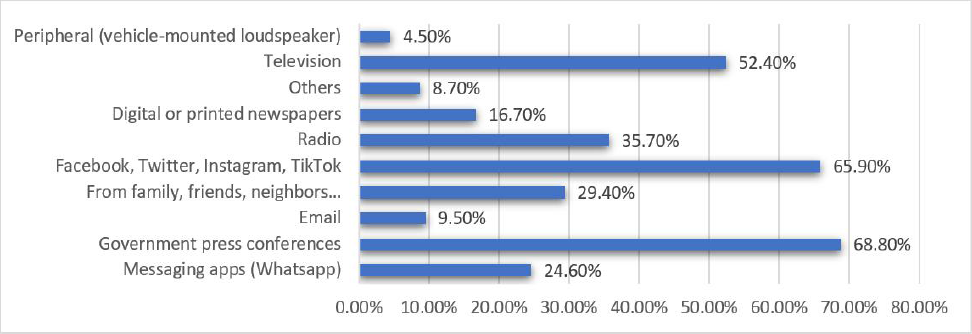
Source: Own elaboration, based on fieldwork data.
Fig. 1 COVID-19 Information channels and prevention measures
And so, young people have a strong interest in receiving information about COVID-19, along with protective material to face it (masks, antibacterial gel, soap…). According to their answers, it is remarkable the need for psychological care, as well as receiving consultations and medicines at home.
Youth participation during and after contingency is very important for rebuilding the social fabric and empowering individuals. When asking if they have participated in any special activity, such as social service, during the contingency, almost half of the interviewed people, said they do not participate in any activity, and those who participate, do so through digital movements, i.e. perform online or virtual activities.
Confinement has generated great concern among young people since they wonder about situations of short-term concerning to their family and personal financial aspects, and the preoccupation with not having the right access to health services, as well as the possibility of losing close friends and family members. Also, the thought of not being able to get post-health contingency work is something they worry about. Thus, for young people, the main areas affected include work stability, work opportunities, and the fear of losing beloved ones.
Young people believe that this health contingency affects significatively many aspects of their daily life. It is notable that young people think their work stability is at stake, as well as their work opportunities. Another notorious concern is that school cycles will not be completed satisfactorily for them.
Besides, they consider that some of the affected areas by the contingency depend directly on the prevention, containment, and mitigation measures implemented by the different levels of government. Then, young people believe that financial support should be generated by the State, as well as the freezing of service payments and tax forgiveness and that there should be spaces for vulnerable people and support networks to prevent or combat gender-based violence.
Health
An important issue is the health of the youth. During this pandemic, certain aspects had become relevant, such as mental and physical condition. First, it is important to stablish their current health condition to set parameters.
As for mental health conditions during a contingency, it could trigger various problems in young people, such as difficulty sleeping, anxiety, and feeling uncertainty about the future. It must be said, sadly, that one of five youngsters have thought about suicide.
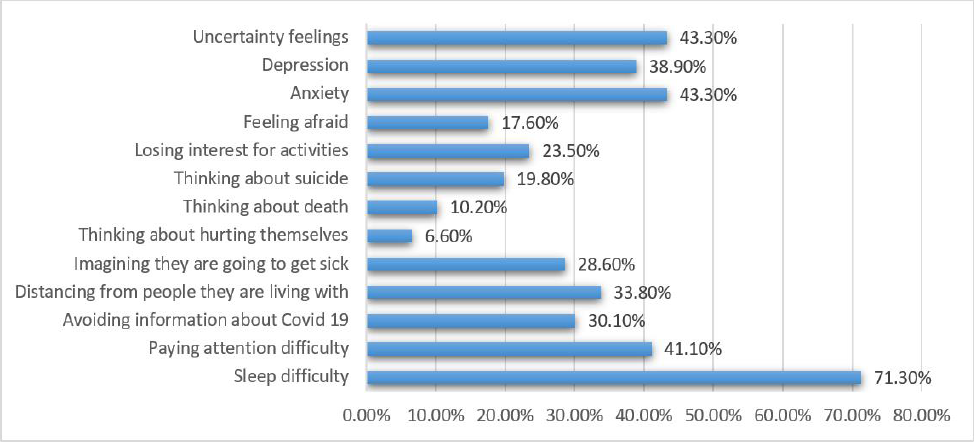
Source: Own elaboration, based on fieldwork data.
Fig. 8 Experienced situations in the last month of confinement.
Also, the use of various substances in young people is a factor that has been presented in recent months. As was expected by this kind of situation, it was found that there was an increase in substance use, with alcohol being the main consumption, also finding that the age range is between 22 and 27 years.
Violence
The conditions generated by contingency cause risk factors for individual and collective violence to increase; as the physical distancing increases, the barrier for promoting security conditions, aid, reporting, and access to reporting mechanisms increases, and in this sense, we find that 58.7% consider gender-based violence to be high, and in contrast, we find that 63.4%, appreciates that it does not exist, or they do not know whether there are the means to ask for help in cases of gender-based violence during the contingency. Study subjects were also asked about the perception of safety in the habitable zone where they live during the contingency isolation period and found that 54.9% perceive that safety levels are regular.
Over the past few months, gender-based violence has also brought changes, debating if these changes have been due to the drop in reported complaints or cases. Therefore, participants were asked about their perception of this phenomenon. It is appreciated that 58% considered that it has increased and 32.4% argue that there are the same pre-confinement levels.
During the contingency, people have spent most of the day at home, so they were asked if they were the victim of some form of verbal violence within their home, 8.7% responded affirmatively; while 86.5% responded that they did not and 4.8% preferred not to say so. In the case of physical violence such as pushing, punching, pinching... 94.4% of participants did not mention being a victim, while 5.6% mentioned suffering from physical violence at home. In emotional violence such as threatening, humiliating, be jealous with, ignore, insulting, banning... 75.4% said they did not suffer this type of violence, and 20.6% reported falling victim to these actions and 3.2% preferred not to say so, and 0.8% did not respond. Finally, when asked if during the contingency someone exceeded the limits of the sexuality of the participants, such as harassing, abusing, raping... 1.6% equivalent to 22 people, were found to have been violated in their sexuality.
Education and Employment
In this variable the question asked about their economic activities turned out that 34.1% (473) subjects are working, 20.6% (286) are only studying, 22.2% (308) work and study and finally, 23% (319) are not working or studying; However, taking into account this classification, we present some results by classifying them by each of these categories.
Young Students
In this category, the subjects were questioned whether their studies have been changed, we found that of the 286 young people, 92.3% responded that their face-to-face classes were cancelled and resumed online, and 7.7% declare that they no longer receive classes in any online modality. In terms of learning, 46.2% believe that it declined considerably, and also, 61.5% consider that their studies will be somewhat affected. They were also asked whether they have started further studies and 42.3% answered affirmatively.
Young people working
Young people who only work, 473 of them, were questioned about who their main employer is, showing in response that 39.5% work in the public or government sector and 37.2% work in the private sector; on the other hand, they were questioned about changes in their workspace, so 34.9% have not changed their workspace, 30% moved to work at home and 27.9% do so mixed, i.e. at home and in their workplace; similarly, 69.8% of respondents felt that their productivity has declined considerably.
Young people who work and study
In this category they were questioned whether their studies have been changed or not, we find that 75% of the 319 young people, cancelled their face-to-face classes and resumed them online, and 17.9% declare that they no longer receive classes in any online modality and finally, 7.1% remain the same as they received their education virtually. In terms of learning, 42.9% believe that it declined considerably, and in turn, consider that their studies will be somewhat affected. Of that 78.6%, they were asked if they have started further studies, and 32.1% answered affirmatively.
Of these young people who work and study, 319 subjects, were questioned about who their main employer is and 29.6% answered they work in the public sector or for the government and 33.3% work in the private sector; on the other hand, they were asked about changes in their workspace, they responded 28.6% has not changed their workspace, 46.4% moved to work at home, and 21.4% do so in a mixed manner, i.e. at home and in their workplace, though 64% felt that their productivity has declined considerably.
Consumption Habits
Contingency and confinement have detonated certain behaviors other than everyday behaviors before the pandemic, and to understand habits, it is necessary to know about the electronic devices that individuals have.
When it comes to quality in internet access is a determining factor in individuals' consumption habits, at better quality people are likely to have higher habits than people with little access.
Finally, the confinement has detonated modifications in young people´s activities, having more free time per day. The activities that are mostly carried out are surfing the Internet and the use of social networks, contrasting with the activities that are least carried out such as dating friendships, volunteer activities, and physical activation.
Hypothesis test
We used the SPSS v.24 statistical programs to analyze the data obtained from the fieldwork and the procedure of analyzing non-parametric tests for a single sample was performed; the research has analyzed every question, and it found out that all of our variables are approved. We used binomial tests and chi-square tests for a sample (see Appendix 2).
Discussion or Conclusions
The purpose of this study is to identify the perceptions of the young population from 16 to 29 years in the city of Morelia, Michoacan, Mexico during the health contingency for COVID-19 disease, generated by the new coronavirus SARS-CoV-2.
Through this research, we find that changes in routine and lockdown have forced the youth from Morelia to adapt to different ways of using their time.
Since April 8th, 2020, schools have been suspended nationwide in 188 countries, over 90% of enrolled learners (1.5 billion young people) worldwide are now out of education (Lee, 2020). In Mexico, by October, there are 37, 589,611 affected students. Of which 37% are at secondary level and 11% in tertiary education (UNESCO, 2020). So that, our study confirms that the closure of school facilities, the cancellation of events, and therefore staying at home to prevent contagion, young people are missing important moments of their lives, such as spending time with friends, going to the movies, going out, practicing their favorite sports and activities.
Among the preliminary discoveries we can highlight the following: During the contingency, after the suspension of academic activities at all educational levels in the municipality, a considerable number of young people returned to their places of origin. The vast majority of young people stated being at home and leaving only for essential activities, in contrast, we found that the younger ones claimed that they continue to leave their homes to develop everyday activities. Young people in the city of Morelia are considered informed about the risks, symptoms, and prevention measures of COVID-19.
The principal means of information on the situation of COVID-19 in Mexico, has been the technical press conference of the Government of Mexico; in contrast to Ali, Whitebridge, Jamal, Al-Safy, and Atkin (2020), Social media was the most utilized source for information on the disease (n=4740, 83.5%), followed by the World Health Organization (n=2844, 50.1%). On the other hand, one in four young people has participated in some response activity against the COVID-19, carrying out digital actions or monetary donations in-kind or work. Youth's main concerns are personal finances, family finances, not having access to health services, as well as the loss of family and friends to the disease.
On the other hand, we know now that three out of four people believe that there will be a shortage of job opportunities after the contingency, and job stability will also be affected as it is happening in other parts of the world. Also, the main risk factors for COVID-19 in the young population of the municipality are overweight and obesity. We found that seven out of ten 10 participants declared having some level of these conditions.
Likewise, Rodríguez, Gómez, Vergara, and Gamboa (2020) reported a 3-times increased risk of anxiety in young Colombians over the age of 18, who expressed inadequate management of their emotions. In the present study, the main experienced problem during recent months among young people from Morelia is lack of sleep; at the same time, we find that one in five young people reported initiating, restarting, or increasing alcohol and/or tobacco use in recent months.
During COVID-19 quarantine, the home has become a dangerous place for victims of domestic violence, as they must remain in full detention with their victims, away from people who can validate their experiences and assist them. For those who live in small houses or without open spaces, the level of stress has increased. Nor can the help of grandparents be used, given the invitation to keep elderly people at home and well away (Mazza, Marano, Lai, Janiri, & Sani, 2020)
Regarding cases of gender-based violence, we found that cases increased during contingency; some participants also reported being a victim of verbal, physical, and/or sexual violence, setting a red spotlight on the municipality authorities.
It should also be said that three out of five surveyed young people believe that their work and/or academic productivity has decreased considerably with changes in distance, virtual, and/or online mode. At the same time, we have seen that there is a considerable increase in the time that young people browse social networks and the internet.
The contingency of COVID-19 has led to substantial changes in society, especially the youth of the municipality; over the next few months it will be important to generate spaces where young people can externalize their concerns, problems, and ideas to solve the challenges that are and will be developing in the city of Morelia; it will be important to link them to the institutions so as the generation of public programs since this will give a youthful perspective that can be included in the public sector. As for the revision of the literature, we have found works that include young people, however, since this pandemic quarantine was unexpected, no youth perception studies had been conducted.
This article concludes by stating that it was fulfilled to have identified the perceptions of the young population of 16 to 29 years in the city of Morelia, Michoacan, Mexico, during the health contingency of COVID-19 disease, generated by the new coronavirus SARS-CoV-2.
In the discussion section, the work used to make the contrast was reviewed and we consider that they are all important, so the decision was made to maintain them.
Scopes
With regard to broadening the scopes and limitations, we consider that:
Our greatest scope is to provide the guideline for subsequent studies on the behavior of the young sector of Morelia´s society, Michoacán for the duration of the health emergency. The behavior of young people in the economic, social, affective, substance use aspects will therefore be considered.
Similarly, it can be an example to carry out this type of study in the young sector of other cities of the Mexican Republic, since according to INEGI young people represent more than half of the population. In addition, this study can be adapted to the population of older adults, considering its importance within our society.
Limitations
One major limitation of this study is its sampling technique. Convenience sampling, typically utilized in cross-sectional studies, is a type of nonprobability sampling that allows for data collection from a group of people who are easy to contact or reach (Tyrer & Heyman, 2016).
Also, because of the pandemic, the field of study could not be expanded. The data collected only show a moment during the period from May to July, months in which the interviews were lifted, and of course, the prolongation of the pandemic will greatly affect the results.
Another limitation of this study is that it is only confined to the city of Morelia. Similarly, problems were presented at the time of filling in the virtual forms, as some research subjects abandoned this activity without finishing it.
We plan to address these limitations with future studies aimed at a broader and more diverse sample of the population.











 nova página do texto(beta)
nova página do texto(beta)



